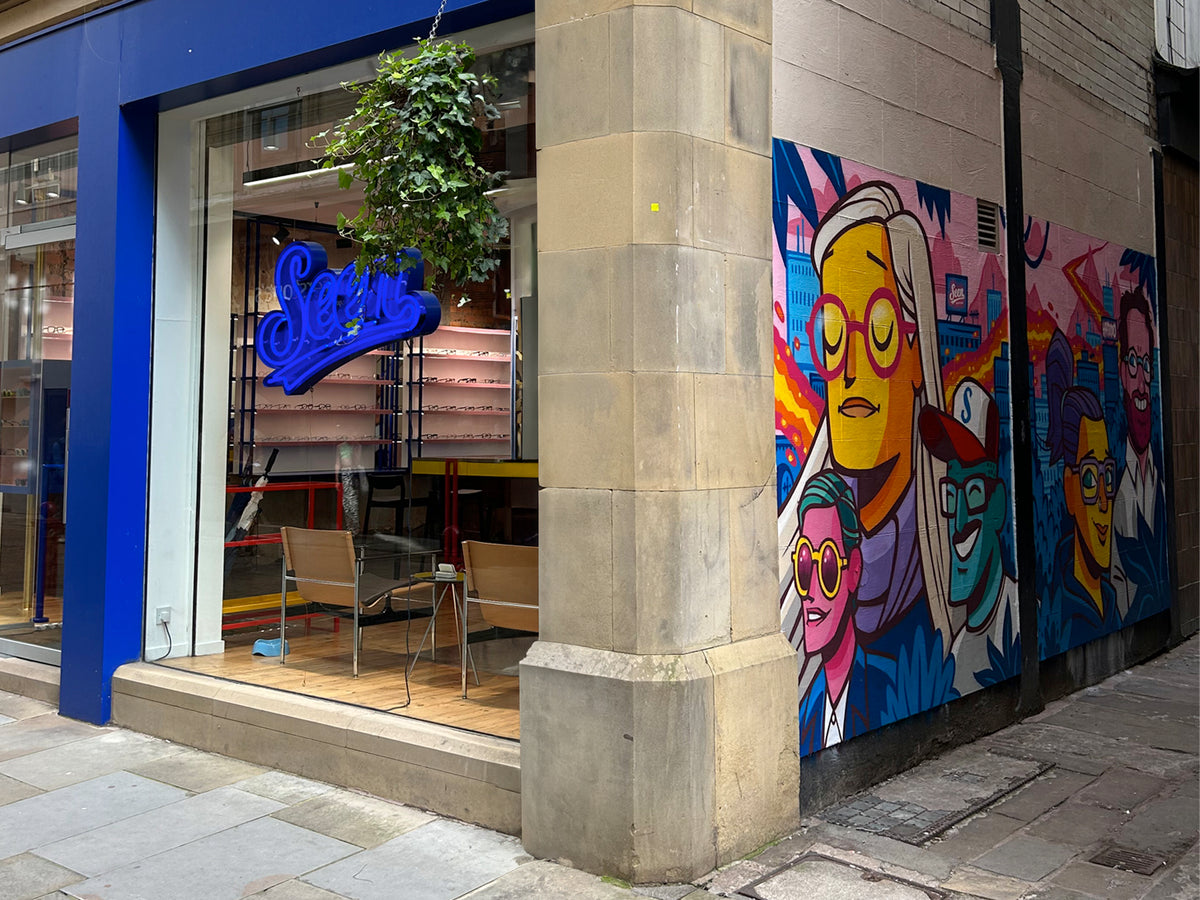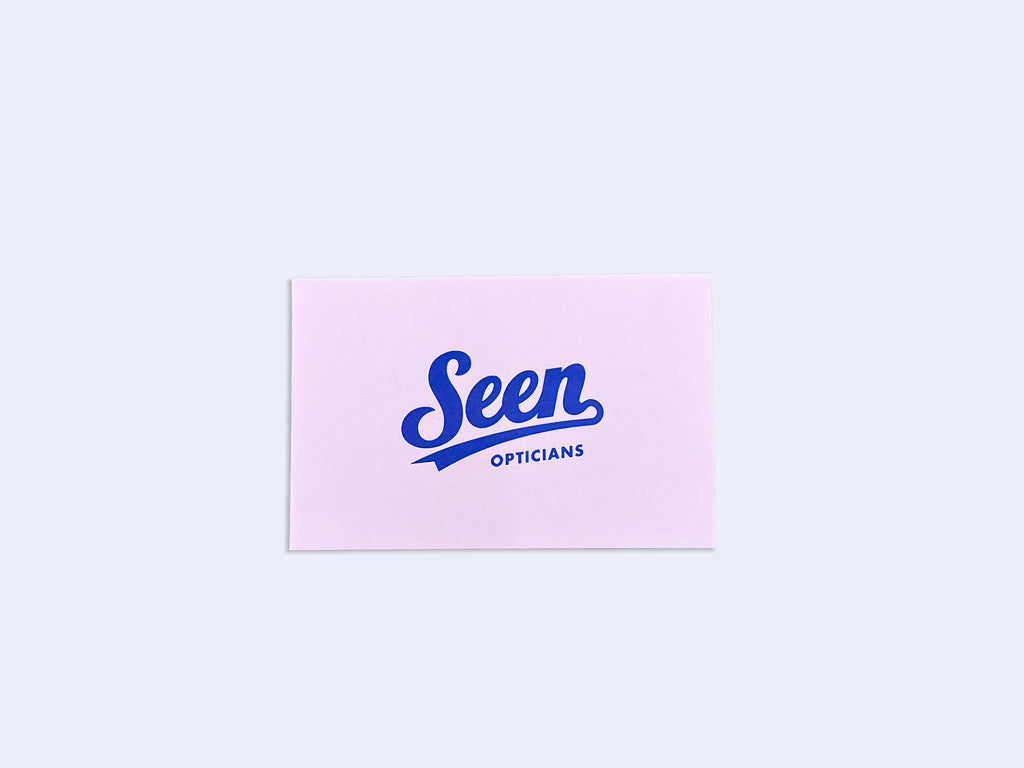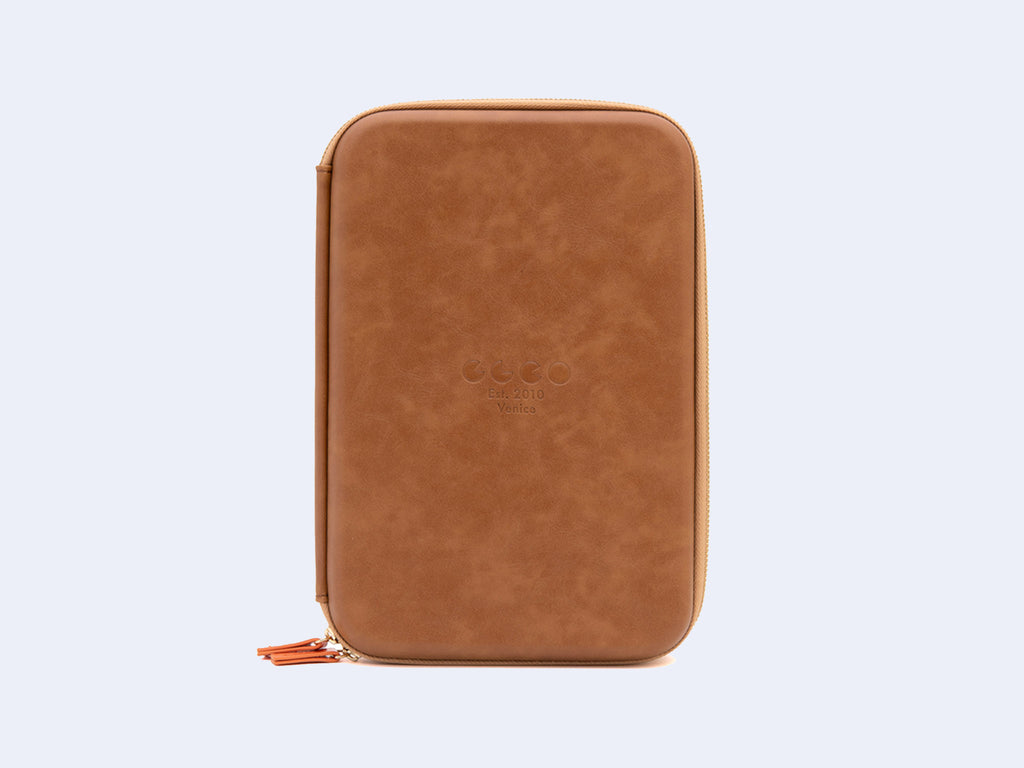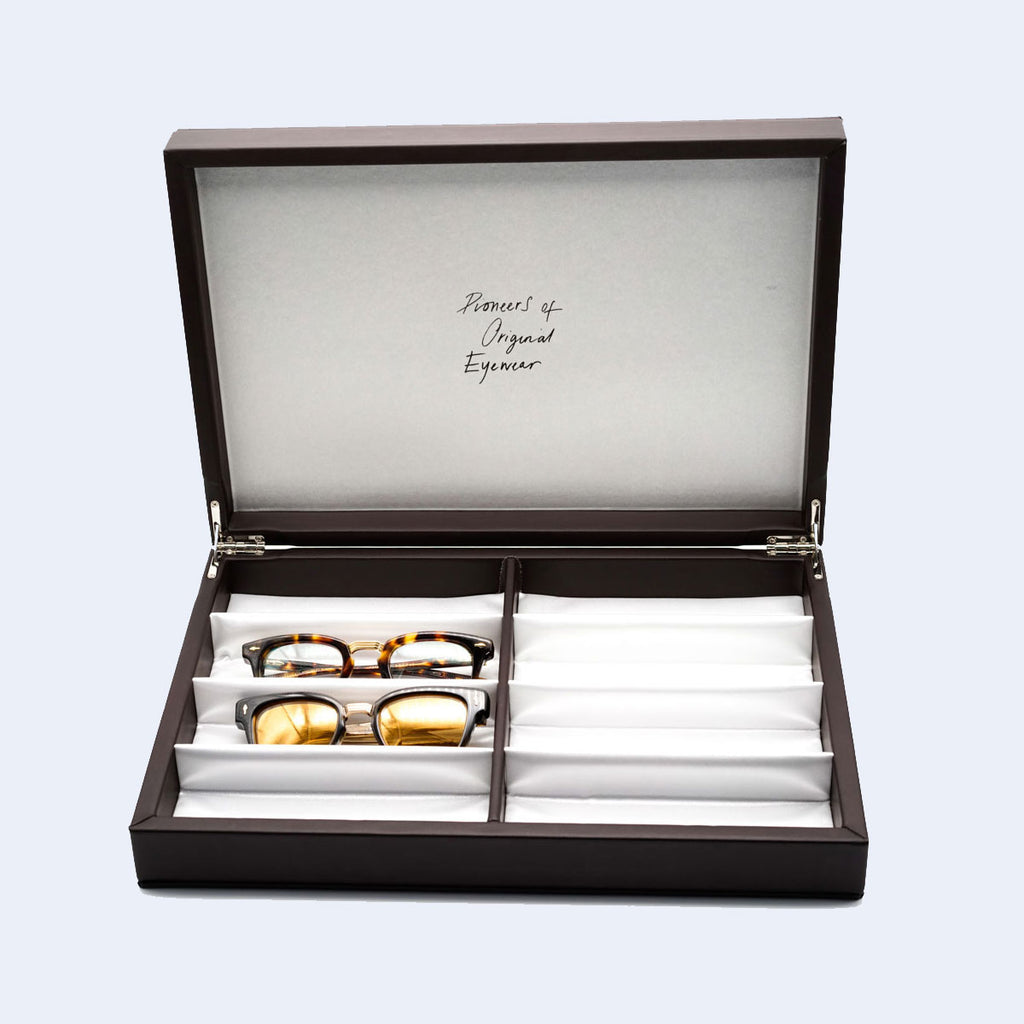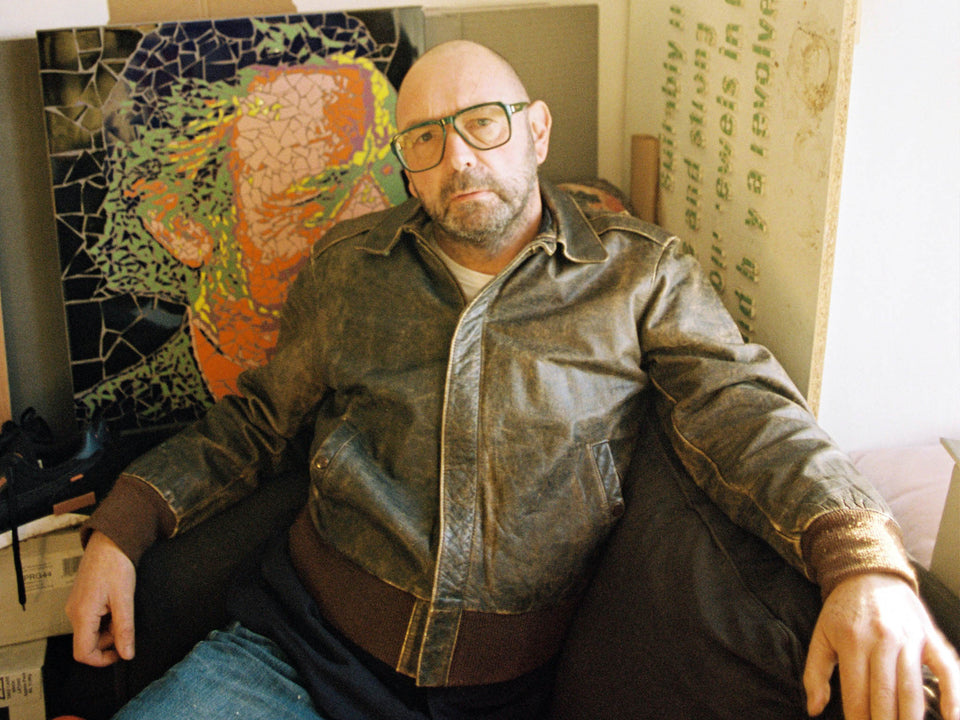If you’ve been down to our shop recently, you’ll have probably noticed the big ol’ mural we’ve had painted on the side of our establishment. The mural in question was the work of none other than Nick ‘Hammo’ Hamilton—an artist and illustrator whose unique characters can be seen everywhere in Manchester, from schools to shop shutters.
Whilst he was around, Hammo also lent his skills to a highly limited run of cleaning cloths for us too which are available right now. And that’s not all—we also managed to collar him for a quick chin-wag. If you ever wondered how people paint murals, then pour yourself a cup of tea and read on…

Hammo himself 📸 David Oates
Going back a bit—has painting something you were always into? Were you always artistic?
When I was a kid most of my time was spent lying on my front with a stack of paper in front of me, drawing Superman and Star Wars characters. I carried it on through school and college and ended up doing illustration in university at Preston.
Even during my course I never really knew what it would lead to—it seemed like the only option would be to do kids books or greeting cards—but I just sort of fell into doing stencils towards the end of university. It was around the time that Banksy started becoming well known, and I thought, “Let’s give this stencil lark a bit of a go.” So I’d turn my own illustrations into stencils, and then spray them onto canvases.
Eventually a shop in town started selling them—a shop called Roadkill Records on Oldham Street. Around that time there were other events like Sketch City and Doodlebug—that was held at the old Cornerhouse, and they’d invite people to draw all over their walls.
'All the stuff I paint is largely intended to bring a smile to someone’s face' - Hammo
I vaguely remember that stuff. How long ago was that?
I think it was in 2005 when I started drawing on walls. And from there mural jobs started popping up—like doing one for the old Koffee Pot on Steveson’s Square.
I suppose murals like this and commissioned street art weren’t really a thing 20 years ago.
It was really underground. If you were doing anything with a spraycan back then, it was usually illegal. But it sort of became popular and normalised to have a bit of fancy artwork up in your cafe or your bar—there was a real boom as it became more accepted.
You’ve got quite a defined style with your characters—was that something you’ve always had or has that developed over time?
When I was younger I was obsessed with Jamie Hewlett’s work—Tank Girl and the Gorillaz—I really liked his angular style. I feel like I chop and change a bit, but I suppose my stuff is quite noticeable. I’ve simplified it in recent years, largely to make it easier to paint. When I first started spray painting I don’t think I was very good with a can, so I adapted my drawing style to make things easier to paint on a bigger scale. I still feel like I don’t really know what I’m doing.
Usually the picture is just on a piece of paper or in my head—so people don’t really know what it's meant to look like. Often when I finish a piece, it won’t look exactly how I pictured it… but if no one else knows that that’s alright. Meanwhile I’m kicking myself because it doesn’t look right, but I’m slowly learning to become less precious about it.
'It started with Tareq saying he wanted showing how Seen were pioneers—and that he wanted something to represent his love of travel.' - Hammo
I imagine a lot of people will see your work—more than if you just made greetings cards or prints. Is there a buzz from knowing so many people will see one of your murals in the city centre?
That’s one of the really nice things about it. It’s almost a side-effect. I just really like putting my pictures on my walls, but it’s a real bonus if people like them. A lot of the time you’re painting you get live feedback from passers-by, which is really nice. 99% of the time, it’s really positive stuff. All the stuff I paint is largely intended to bring a smile to someone’s face, so to have people walk past and comment on it is lovely. I was doing a mural in Eccles a couple of months ago and it was hard to get the work done because 90% of the people who walked past ended up having a chat—saying how nice it was to have a bit of artwork going up in the area. It was lovely.
I saw an old fella in Stevenson’s Square last week standing next to some of my Christmas designs I’ve done on the blocks there. He must have been in his 80s, and he was having his photo taken by someone I assumed was his grandson—he was giving a thumbs up by this Santa Claus that I’d done. The kid took the picture, but when he was done he gave the man his phone back and they walked off in different directions. This old guy obviously just wanted his picture taken with this Santa—and that was a really heartwarming moment.

Santa himself
Are there certain things you find yourself painting all the time? Are there certain characters or themes you come back to?
They’re always characters—usually because I can’t be bothered drawing backgrounds. And there’s often little nods to my daughter in there—I’ve done that since she was born—whether there’s a character or a little reference to her, I always like to stick stuff like that in. It’s usually not too different from the sort of stuff I used to draw in my school books back when I was a kid—stuff to make myself or my friends or my sisters laugh.
I suppose there’s a theme of slightly whimsical characters—I’ve been gravitating to more nature based things lately—like kids exploring the outdoors. Since we got a dog I spend most mornings out walking him, and you become more aware of the changing seasons and mushrooms sprouting up and the leaves changing colour. It’s really nice to be engaged in what’s on your doorstep—so it’s nice to try and get some of that into my stupid drawings.
What’s your process of doing these murals? Talk us through how you did the mural for Seen?
It started with Tareq saying he wanted showing how Seen were pioneers—and that he wanted something to represent his love of travel. And obviously it had to have faces with glasses. The guy on the far right of the mural is my friend Neil who introduced me to Seen a good few years ago.
I came up with a few pencil sketches—I started with a bunch of faces and arranging them in a landscape—showing some kind of imagined city landscape in the background to give some sense of travel. From there it was a case of drawing it up quickly and throwing a bit of colour on it—linking it with the shop colours—and then once Tareq was happy with the digital version I sketched it out in spray paint. You kind of work in reverse—filling all the big areas in colour, and adding the outlines on last. It’s a relatively simple process.
Spraypainting onto a wall now feels like the final stage of the process. I used to just draw stuff and have a picture on a paper—but now the process doesn’t feel finished until the picture is sprayed onto a wall somewhere.
I imagine it’s hard to space this stuff out. Like when Neil Buchanan used to do those ‘Big Art Attacks’, I always used to wonder how he managed to get to make his pictures work when they were so big. Are you blocking it out a bit?
I sometimes sketch out a bit of a grid—separating the wall into maybe six squares and then drawing a corresponding grid over the printout I’ve got. It’s sort of like in GCSE art when you’ve got a drawing of an apple, and you put a grid over it—then draw that grid on a bigger bit of paper and copy what’s in each square across. And if it’s an indoor mural I use a projector—so I’ll beam the image onto the wall. It’s kind of what the old masters used to do. They used what were called cartoons—they had tracing paper with the design drawing on it, and they’d prick holes around the outlines and pat dust through it to leave the design on the wall.
So they were cheating!
Yeah. They had the technology.

Seen mural in progress. Photo: Tareq Mustafa
What’s going through your head when your painting your murals? Do you get into that state where you don’t have to think?
I kind of do, yeah. I’ll just stick some music on and see what falls out of my head and onto the page. The actual painting is quite therapeutic—it’s quite a meditative process because I don’t have to think that much. You just get lost in what you’re doing. It’s quite a relaxed state when it’s going well. When it’s not going well and I’ve spent 20 minutes trying to draw a hand, I might have to go for a walk. But when it’s going well, it’s nice to get lost in little details.
What’s the feeling when you step back from it? I imagine when you’re working on something of this scale, there’s an element of uncertainty—but how do you feel when its finished?
Usually nowadays it’s satisfaction. There used to be times in the past when I’d step back and think, “That’s awful.” But I’ve been doing it long enough now that most of the stuff I do ends up looking how it's supposed to.
How does it feel to put so much effort into something that’s ephemeral? These murals don’t stick around forever—does that change how you think about them?
I think that’s one of the aspects about it that I quite like—it’s not going to last forever. There’s a certain buzz when you see an old piece that’s still up there, but at the same time I don’t think there’s any public artwork that I’ve done that I’m precious about. I know that it’s going to end up getting defaced or painted over at some point. So if I go into it knowing that, you resign yourself to that fact that it’s a transient medium.
And you’ll always have photos.
Exactly. There’s a guy called Mike who owns a scrapyard down in Crewe, and he puts this thing on down there called the Junkyard Jam, where you paint these old caravans and cars. And at the end of the day, they all get destroyed—he smashes them with his big grabby claw. It’s the act of painting itself that’s the fun bit—and the fact it gets smashed at the end is a little bonus.

Junkyard Jam mural moments before it gets smashed to bits
I suppose most art is commodified. It becomes about how much something is worth—with pieces kept away in light proof drawers, accumulating value. But your stuff is set aside from that. It can’t be hoarded or claimed.
Yeah—unless it’s a Banksy and someone takes the side of a pub off and sells it to a businessman.
Are there any really old murals of yours still up in Manchester?
I was going to say the shutters of Fresh Bites in the Northern Quarter, but that was finally painted over a few weeks ago. There were some shutters that used to be up at Fred Aldous that I painted a mummy on, and this guy called Liam who makes these ace sculptures, he’s reclaimed them. They’re in his studio in Denton now I believe—so there’s still a few bits knocking around somewhere.
'It’s unbelievable really. It doesn’t feel like a job.' - Hammo
I suppose once it’s out in the world, you don’t know what’s going to happen. It might end up in the background of a TV show.
Yeah—it’s usually my mum getting in touch saying, “I’ve just seen your mural in the back of Happy Valley. I hope you’re going to get some money back for that.” You can actually claim royalties if your paintings are in the shot.
Wow—I didn’t know that. Looking back at your childhood constantly drawing—is it weird that you can now make a living basically doing the same thing?
Yeah, very much so. I feel very lucky that I can. There are times when you might not know where the next job is coming from—being self employed can be a bit nerve wracking—but it’s really nice and gratifying to be able to draw stupid stuff and get paid for it. It’s unbelievable really. It doesn’t feel like a job.
 Oncology mural at Royal Manchester Children’s Hospital
Oncology mural at Royal Manchester Children’s Hospital
Wrapping this up now, is there any particular mural that you’re particularly proud of? Is there one you’re really happy with?
It’s not even really a mural—it was digital work that was printed on some vinyl plastic—but it was some work for the Royal Manchester Children’s Hospital in the A&E department and the Oncology and Haematology Ward. I had to come up with a bunch of alien characters on this racetrack. I like work like that—things that people can engage with—things that might raise a little smile.
